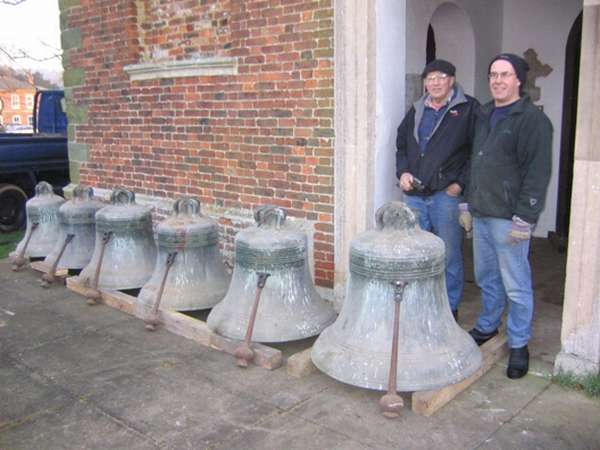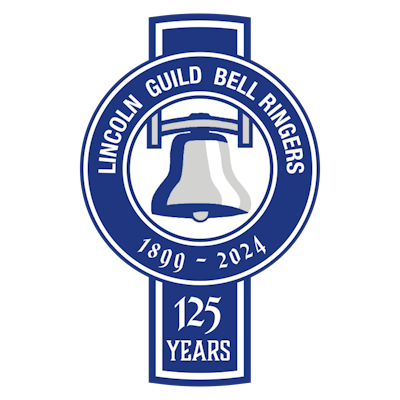Langton by Spilsby* restoration - Work in progress!
March 2008: The bells are to be rehung in the two weeks after Easter and will be rededicated by the Bishop of Lincoln at 1030 on Sunday 31 August 2008.

January 2008: Since the update below, the bells were removed from the tower around 19 December, and are shown above, together with (l-r) Peter Scott and Neil Thomas, bellhangers from Whitechapel Bell Foundry.
Update as at 23/11/2007: I have received information from David Douglas, who has been leading the project to restore the bells of St Peter and Paul's church Langton by Spilsby, that a very substantial grant has been agreed by the Heritage Lottery Fund. This together with other grants from the Georgian Group, Kochan Trust, Sharpe Trust, Lincoln Diocesan Guild and others will enable the project to restore this unique ring of six bells to full circle ringing by the Whitechapel Bell Foundry. The work is expected to be completed by April 2008.
The original article, which also appeared in The Ringing World, follows:
Langton by Spilsby* bells to be restored
A fundraising scheme has recently been launched to restore the six bells at the church of St Peter and Paul, Langton by Spilsby after a silence of over fifty years. Ringers from Alford and Spilsby regularly rang the bells for special services and for practice, and also maintained them, until a new ceiling was installed in the porch in 1956, from where the bells were rung during a restoration of the church interior. Unfortunately no provision for ropes was made, and ringing ceased. Just before this, on 14th July 1956, the only peal on the bells was rung by a visiting band, and it was never possible for those who had maintained and rung the bells to achieve a peal. The bell installation has not been touched since installation, and now need attention.
To reach the church, when travelling along the A158 Lincoln/Skegness road, about halfway between Horncastle and Skegness, you will come to a crossroads close by the magnificent spired church of St. Andrew, Sausthorpe. Turn left here and after a few hundred yards bear right, and proceed gingerly along a typically inebriated Lincolnshire by-road. After negotiating a very sharp right bend Langton church suddenly appears looking down from the top of a small hill.
The church is of brick and was probably built circa 1720-30[1]. The west end has a stone doorway through which one gains entry to both the church and ringing room. An octagonal bell turret with circular openings in two tiers was added circa 1825. There is no electric light and candles are used for evening services in winter.

The interior has a three-decker pulpit and box pews facing inwards and there is a west gallery. Looking at the church from the road few ringers would expect to find six bells in such a building. Indeed, this must be one of the most unusual 'towers" containing bells hung “full-circle” in existence.
The bells were cast in 1825 by Thomas Mears and were the gift of John Stephen Langton the then Lord of the Manor who died aged 37. Much of the correspondence leading up to the installation of the bells still exists[2]. On 27th April 1825 local carpenter Robert Willerton agreed to make a bellframe and floor to the bell chamber and also to hang the six bells for £118. Fifty pounds of this was to be paid when the frame was put up and the remainder "within one month after the job shall have been finished to the satisfaction of the Hagg[worthingham] and Spilsby ringers".
On 2nd September 1825 Thomas Mears wrote to John Stephen Langton saying that the ring of six bells with stocks, wheels, clappers, rollers, ironwork and brasses had been shipped on the Lively to Boston. He went on to state that an additional two trebles would weigh 8 cwt. 21b. and it seems possible that, had Squire Langton lived, there may have been a ring of eight in due course.
Mears gave the weights of the three old bells as respectively 7 cwt 3 qrs 8 lbs; 5 cwt 3 qrs 2 lbs; and 5 cwt 2 qrs 24 lbs[3]
On 9th December 1825 Mears wrote acknowledging payment of £220 15s 2d
Details of the bells are as follows :
Treble. T MEARS LONDON FECIT 1825 Diameter 28” weight 4 cwt 2 qrs 20 lbs
2. T MEARS LONDON FECIT 1825 Diameter 30” weight 5 cwt 1 qr 15 lbs
3. T MEARS LONDON FECIT 1825 Diameter 32” weight 6 cwt 26 lbs
4. T MEARS LONDON FECIT 1825 Diameter 33.25” weight 6 cwt 2 qrs 1 lb
5. T MEARS LONDON FECIT 1825 / WE WERE GIVEN BY JOHN STEPHEN LANGTON ESQ /
LORD OF THIS FREE WARREN Diameter 34.75” weight 6 cwt 3 qrs 24 lbs
Tenor. T MEARS LONDON FECIT 1825 / ARE YOU PREPARED FOR ME TO CALL YOU HERE
Diameter 38.75 weight 9 cwt 2 qrs 14 lbs Note G
There is also a manually operated chime barrel by Bailey & Co of Salford which sounds the first six changes of the plain hunt on six bells.
After John Stephen Langton’s death the Rector wrote that he had given the church ‘a ring of the sweetest bells in Lincolnshire to one of the ugliest churches in Christendom’ – clearly an opinion which was not shared by Sir John Betjeman who described Langton church in about 1956 as ‘one of the most attractive and interesting churches in Lincolnshire and therefore England, because Lincolnshire is rich in remarkable churches’[5]
Ever since a medieval landowner took as his surname ‘Langton’ during the reign of Henry II (1133-1189) there has been a continuous line of Langtons at Langton. William Langton was President of Magdalen College, Oxford from 1610 – 1626. Samuel Johnson stayed with his great friend Bennet Langton in 1764 when he may have visited the church which would have had hanging in it the three medieval bells mentioned in the 1552 Inventory[4]. Sadly with the death of John Langton in 1989 the male line died out but one of his three daughters with her family will shortly be returning to Langton and her husband David Douglas is masterminding the scheme to rehang the bells.
The adult population of Langton is only about 31, so it is a very big undertaking[6]. Approximately £40,000 is needed to restore these bells to full-circle ringing. Such an unusual installation should, in my opinion, be restored so if you would like to support this ambitious scheme please contact David Douglas, 25 Ferry Path, CAMBRIDGE, CB4 1HB. Telephone: 01223 361819. Email: [email protected].
Sources
1. Pevsner, N. and Harris J The Buildings of England : Lincolnshire p. 292 and
Jenkins, S. England’s Thousand Best Churches.
2. Lincolnshire Archives Langton/9/3.
3. It seems likely that these were the bells listed in the Inventory of Church Goods belonging
to "Lantonjuxta ptnay" made in 1552 - It' iij bells and one litle belle. xli.
4. Lincolnshire Bells and Bellfounders p. 129.
5. Hillier, B. John Betjeman: New Fame, New Love (2002) quoting from a pamphlet by
J. S. Thorold, Rector, J. C. P. Langton and F. W. Walter circa 1960.
6. Lincoln Diocesan Directory p.113
* Note: The entry in Dove Online is under Langton by Partney
